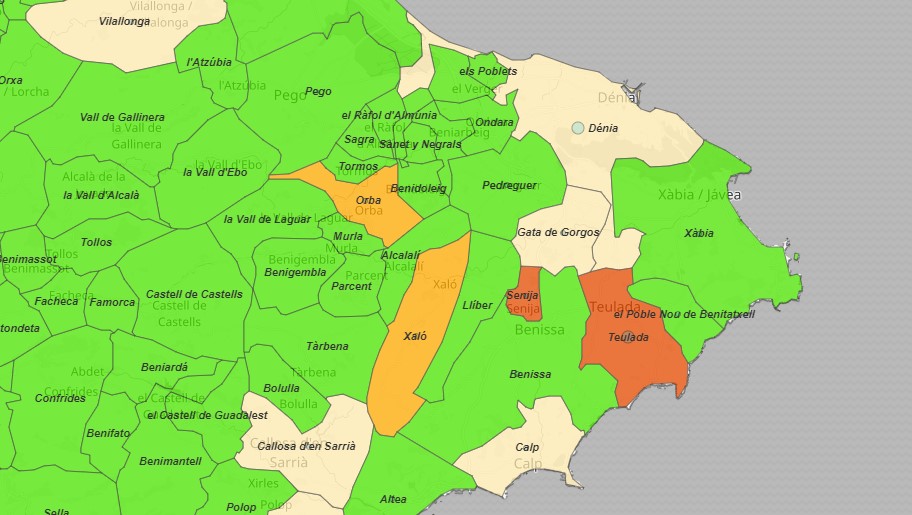VIRUS UPDATE: Two new positives in Xàbia but overall infection rate is down
Spain’s 14-day IA rate is 188.97 cases per 100,000 inhabitants, placing the country in the ‘High Risk’ category but it has dropped almost 20% in the past two weeks.

Tuesday 11th May 2021 – Compiled by MIKE SMITH
Two new positive cases were detected in Xàbia in the latest update from the regional health ministry, taking the number of positive cases recorded in the town since the beginning of the pandemic to 1,458.
However, the municipality’s 14-day IA rate, a measure of the speed at which the virus moves through the population, has dropped to 10.71 cases per 100,000 inhabitants, the lowest since mid-March and a figure which places the town in the ‘New Normal’ category of infection. In addition, there have been no new deaths since late March and the number for Xàbia remains at 12.
In the Marina Alta region as a whole, a positive case in Senija has lifted the municipality into the ‘High Risk’ category along with Teulada, who detected another three cases since the last update. Three positives in Xaló means that it has risen into the ‘Medium Risk’ category along with Orba, whilst Calp (+6), Dénia (+3) and Gata de Gorgos (+2) find themselves in the ‘Low Risk’ category. Both Benissa and Poble Nou de Benitatxell detected a positive case each but they remain in the ‘New Normal’ category.
In total, there have been 22 new positive cases detected in the Dénia Health Authority – which covers the Marina Alta – which means that the 14-day IA rate has risen slightly to 35.16 cases per 100,000 inhabitants. Thankfully, there have been no new deaths since the beginning of the month and the region’s toll remains at 202.
Spain
Spain’s 14-day IA rate is 188.97 cases per 100,000 inhabitants, placing the country in the ‘High Risk’ category. The rate has dropped almost 20% in the past two weeks, along with the Positivity Rate, the measure of how many coronavirus tests return positive, which has dropped to 6.09%, its lowest level since the beginning of April; a value of 5% or less would be indicative that transmission of the virus was under control.
Across the autonomous regions, the País Vasco still leads the way with a 14-day IA rate of 402.26, placing it firmly in the highest ‘Extreme Risk’ category along with four others – Madrid, Aragón Navarra and Melilla – whilst the Comunidad Valenciana (35.61) remains the only region in the ‘Low Risk’ level. Infection spread has dropped in all regions for the first time since the beginning of March and has dropped by almost in quarter in almost all of them over the past two weeks, the exceptions being Aragón and the Baleares.
The newspaper El País has reported prime minister Pedro Sánchez is confident that Spain will reach herd immunity by mid-August, that is, achieving the 70% threshold of the population vaccinated and immunized. The vaccination campaign hit several snags during the first few weeks, including shipment delays and the suspension of specific vaccines, but has hit cruising speed in recent weeks, with more doses administered during April than during the first three months of the year.
A study by the regional government of Navarra has identified that coronavirus infections fall when the interiors of bars and restaurants are closed. All of the drops in the 14-day IA rate have corresponded with such restrictions on the hospitality sector, suggesting that a limit on activities indoors helps to stop the spread of the virus. Health experts have agreed that one of the tools that regions have at their disposal now that the national state of alarm has ended is to encourage outdoor activities and avoid the gathering of groups of people inside. “If you meet with your friends, make sure it’s outside.”
Vaccination (10.05.21)
Spain has administered 19,830,624 doses of vaccine, which is 94.0% of those which it has already received. A total of 6,221,476 people have completed the recommended course, which is 15.5% of the total of the population which is to be vaccinated (40,129,822).
According to the latest data provided by the health authorities, 86.7% of people aged 60 and over in Spain have received at least one dose, with 40.1% having completed the recommended course.
The Comunidad Valenciana has administered 1,988,597 doses of vaccine, which is 95.5% of the total which it has received. A total of 638,127 people have completed the recommended course, which 14.9% of the population which is to be vaccinated (4,289,305).
According to the latest data provided by the health authorities, 81.0% of people aged 60 and over in the Comunidad Valenciana have received at least one dose, with 40.6% having completed the recommended course.
LINKS
- Actualización nº 371. Enfermedad por el coronavirus (COVID-19). 10.05.2021
- GIV COVID-19 Gestión integral de la vacunación COVID-19
- COVID-19 C. Valenciana: Monitoratge de la situació




